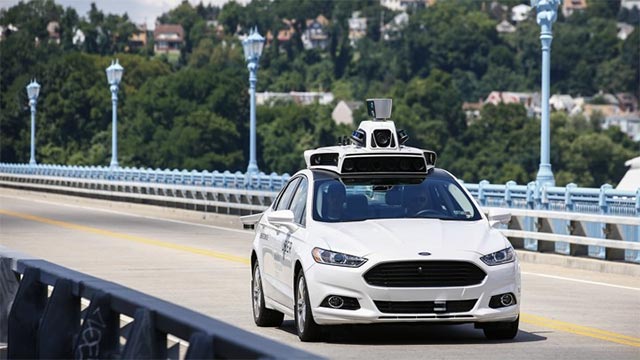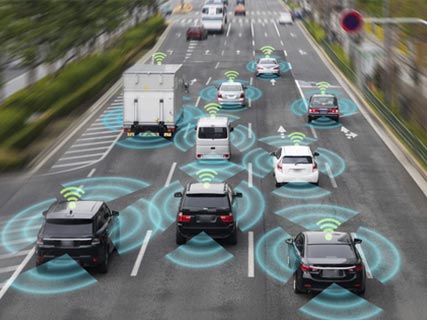AI classifies objects on the road only by radar measurements
Whether future modern self-propelled cars can truly distinguish objects while in traffic, such as between cars, trucks and pedestrians based on radar data ? Absolutely, and all thanks to AI. In a new paper published on Arxiv.org last week with the title: 'Radar-based Road User Classification and Novelty Detection with Recurrent Neural Network Ensembles' (roughly translated: Classifying objects in actual participation New traffic and discovery based on recurrent neural networks, scientists from Daimler Automobile Corporation and Kassel University, Germany have described in detail a novel machine learning framework that can be clearly classified It is clear that individuals and vehicles are engaged in traffic only by data obtained through the vehicle's radar system. Without introduction, it can be seen that this model is particularly suitable for application in the automotive industry in particular and the transport sector in general, in which, self-propelled vehicles will probably be the aspect. benefit the most.

- MIT strives to develop an AI model that can drive almost like a human
'The overall classification performance can be significantly improved when compared to current object identification methods and in addition, the number of identifiable objects will be more, along with the improvement. A clear good defense of accuracy, "the team said. In addition, as explained by scientists, radar is one of the few types of sensors that can directly measure the velocity from many objects in sight and in particular it is much more powerful than many types. Other sensors when operating in adverse weather conditions such as fog, snow or heavy rain. However, few devices can be 100% perfect and radar sensors are no exception. It has a relatively low angle resolution compared to most other sensors, making it difficult to display dense and clear data on the screen.
The team's solution in this case is to use a set of classification tools including 80 short-term memory cells (LSTM) or special recurrent neural networks (here are mathematic functions that mimic biological neuron structures - a technology in deep learning technology that is capable of learning and remembering long-term dependencies. In particular, scientists only need to use a subset of 98 features - namely, statistical derivatives of scope, angle, amplitude, Doppler; geometry characteristics, and features related to Doppler value distribution - to determine the main differences between objects that need to be identified, and do not require computational power, processing too high in the process Model training and reasoning.

- The difference between AI (Artificial Intelligence) and Cognitive Computing (Cognitive Computing)
To train these machine learning models, the team found a data set containing more than 3 million data points of more than 3,800 cases of traffic participants. These training models were acquired through four radar sensors mounted on the front half of the test vehicle (with an effective range of about 100 meters). After training, as a result, these machine-based classification models were able to arrange the objects it detected, including pedestrians, pedestrian groups, bicycles, and cars. , trucks and garbage, into categories corresponding to relatively high accuracy.
Specifically, the 'pedestrian group' category will be assigned to pedestrian data in which the system cannot identify the clear separation between the image of each individual obtained through radar data. . On the other hand, the 'garbage' and 'other' categories will include foreign objects and traffic vehicles that the system cannot identify, or misidentify. In other words, objects classified into these two categories are rated as not suitable for any other classifications mentioned above (such as motorcyclists, scooters, wheelchairs, cables). hanging and cats and dogs).

- Japan's artificial intelligence has created ultra-realistic virtual fashion models
So how accurate is this advanced classification system and can it be used in the near future? According to the researchers, they have an average accuracy of up to 91.46% in subjects classified and even more accurate when sharing the same set of characteristics. Clearly, most classification errors often occur between pedestrians and pedestrian groups due to complex similarities between the two categories. At the same time, there are some other cases of confusion related to the characteristics and shapes of objects. For example, the system may misidentify a person in a wheelchair and a small scooter driver.
Leaving aside those not so significant errors, the team believes that this proposed structure can allow new insights into the importance of characteristics for identifying between multiple categories. individually, it is very important for the development of new algorithms as well as requirements for sensor systems. In addition, the ability to identify objects flexibly from different categories with objects seen in training data also plays an important role in developing self-propelled vehicle technology.

- AI uses WiFi data to estimate the number of people in a room
In the future, scientists plan to improve current results by adopting high-resolution signal processing techniques, which can help increase radar resolution in terms of impact range and angle. Impact and Doppler.
You should read it
- Google released the TensorFlow machine learning framework specifically for graphical data
- Russian neural networks help radiologists analyze images
- 6 photo editing software using Artificial Intelligence to 'elevate' your image
- Building Neural Network to learn AI
- Successfully developed self-propelled bicycles using AI chips capable of reasoning and learning like humans
- MIT strives to develop an AI model that can drive almost like a human
- How can the AI see us behind the walls?
- 14 photo editing software that uses Artificial Intelligence to 'enhance' your photos
May be interested
- Principles for traveling on the road to ensure safety in stormy days
 holding on to these tips will help you to be safer when forced to move during a stormy day.
holding on to these tips will help you to be safer when forced to move during a stormy day. - Instructions for downloading and installing the game Road Rash on Windows 7 without errors
 road rash is a legendary racing game, associated with the childhood of the 8x and 9x generations. however, when installing on windows 7, many people encounter errors that prevent them from playing. this article will help you download and install road rash easily, fix errors for the smoothest experience.
road rash is a legendary racing game, associated with the childhood of the 8x and 9x generations. however, when installing on windows 7, many people encounter errors that prevent them from playing. this article will help you download and install road rash easily, fix errors for the smoothest experience. - Review: Billion Road - Experience the giant Japanese street
 combining familiar billionaire chess play with unique and funny 'innovations', billion road promises to be a fun game for you.
combining familiar billionaire chess play with unique and funny 'innovations', billion road promises to be a fun game for you. - The world's longest straight road of 240km, without a single curve
 the title of longest straight road in the world belongs to the nearly 240km long highway section through the vast rub-al-khali desert in saudi arabia because there are no bends or turns.
the title of longest straight road in the world belongs to the nearly 240km long highway section through the vast rub-al-khali desert in saudi arabia because there are no bends or turns. - How to Remove Unwanted Objects from Photos Using Adobe Express's Remove Objects
 most editing apps today offer object removal features that save you the trouble of taking a second photo.
most editing apps today offer object removal features that save you the trouble of taking a second photo. - Sort and group objects in PowerPoint 2016
 users can arrange objects on the slide at will by aligning, ordering, grouping and rotating them in different ways.
users can arrange objects on the slide at will by aligning, ordering, grouping and rotating them in different ways. - How to use Trackr to find objects
 perhaps everyone at least once forgot their wallet, car keys, phone and many other things that they couldn't remember where they left them. with bluetooth trackr tracking device, you can find them easily.
perhaps everyone at least once forgot their wallet, car keys, phone and many other things that they couldn't remember where they left them. with bluetooth trackr tracking device, you can find them easily. - Steps to count objects in AutoCAD
 counting objects in autocad. you are curious to know how many lines, blocks, layers... in the following article, let's learn about simple and quick tips for counting objects in cad.
counting objects in autocad. you are curious to know how many lines, blocks, layers... in the following article, let's learn about simple and quick tips for counting objects in cad. - Watch the spiral path through the forest in Denmark
 join us in watching the spiraling road through the forest in denmark - a unique elevated road to connect people with nature!
join us in watching the spiraling road through the forest in denmark - a unique elevated road to connect people with nature! - The strange story of the British villagers celebrating birthday for a hole in the road
 a british village held a birthday party for a two-year-old pit on the road hoping to receive the attention of the local government.
a british village held a birthday party for a two-year-old pit on the road hoping to receive the attention of the local government.










 The future of AI and people is cooperation
The future of AI and people is cooperation MIT strives to develop an AI model that can drive almost like a human
MIT strives to develop an AI model that can drive almost like a human Microsoft AI creates a real voice with only 200 training samples
Microsoft AI creates a real voice with only 200 training samples EU: AI systems should be developed and implemented in a transparent and responsible manner
EU: AI systems should be developed and implemented in a transparent and responsible manner OpenAI artificial intelligence defeated the current world champion Dota 2
OpenAI artificial intelligence defeated the current world champion Dota 2 Disney's AI model creates animated sequences from scripts
Disney's AI model creates animated sequences from scripts